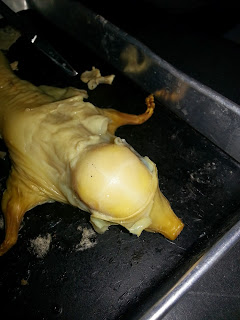·With the presence of oxygen, pyruvate will enter the mitochondrial matrix to be further broken down before the Krebs cycle, this process is called the pyruvate oxidation.
Steps
1. Decarboxylation - one carbon atom and two oxygen atoms are released as a carbon dioxide molecule
2. Oxidation - the remaining 2-carbon fragment is oxidized to form an acetate ion. NAD+ is reduced to become NADH
3. Attachment- the acetyl group of the acetyl ion is attached to a sulfur-based compound, Coenzyme A, to form Acetyl-CoA (2C), which is the end product of the pyruvate oxidation.
Note: step 2 and 3 are coupled reactions
Krebs Cycle
· Each acetyl-CoA enters a cyclic metabolic pathway, called Krebs cycle, that generates NADH, FADH2, and ATP.
Steps
1. Acetyl-CoA(2C) enters the Krebs cycle to react with oxaloacetate(4C) to form citrate(6C). During the process, CoA is removed.
2. Citrate undergoes isomerization to become isocitrate(6C)
3. Isocitrate undergoes decarboxylation to be alpha-ketoglutarate (5C). Meanwhile, NAD+ is reduced to be NADH.
4. -Alpha-ketoglutarate undergoes decarboxylation again, NAD+ is reduced, and CoA is added.
- product: succinyl-CoA (4C)
5. - Substrate phosphorylation. A phosphate group replaces the CoA in succinyl-CoA, and binds to a GDP to form a GTP. Then the terminal phosphate of GTP is transferred to a ADP to form a ATP.
- product: succinate (4C)
6. Succinate becomes fumarate(4C). Another electron carrier, FAD is reduced to become FADH2.
7. Fumarate reacts with water to become malate(4C)
8. - Malate is oxidized to become oxaloacetate (4C)
- NAD+ is reduced to be NADH
9. Oxaloacetate will continue to react with acetyl-CoA
Note:
- for each acetyl-CoA that enters the cycle, 3 NADH, 1 FADH2 and 1ATP is produced.
- Notice the carbon atoms from the original glucose molecule have been removed as CO2 by the end of step 4 (alpha-ketoglutarate → succinyl-CoA)
***Found a diagram that's numbered with steps and is somewhat corresponding to what I wrote above (step 1 is pyruvate oxidation). Also note that the substrate phosphorylation of ATP is not labeled from step 5 to 6, and water is not added into the fumarate from step 7 to 8.














